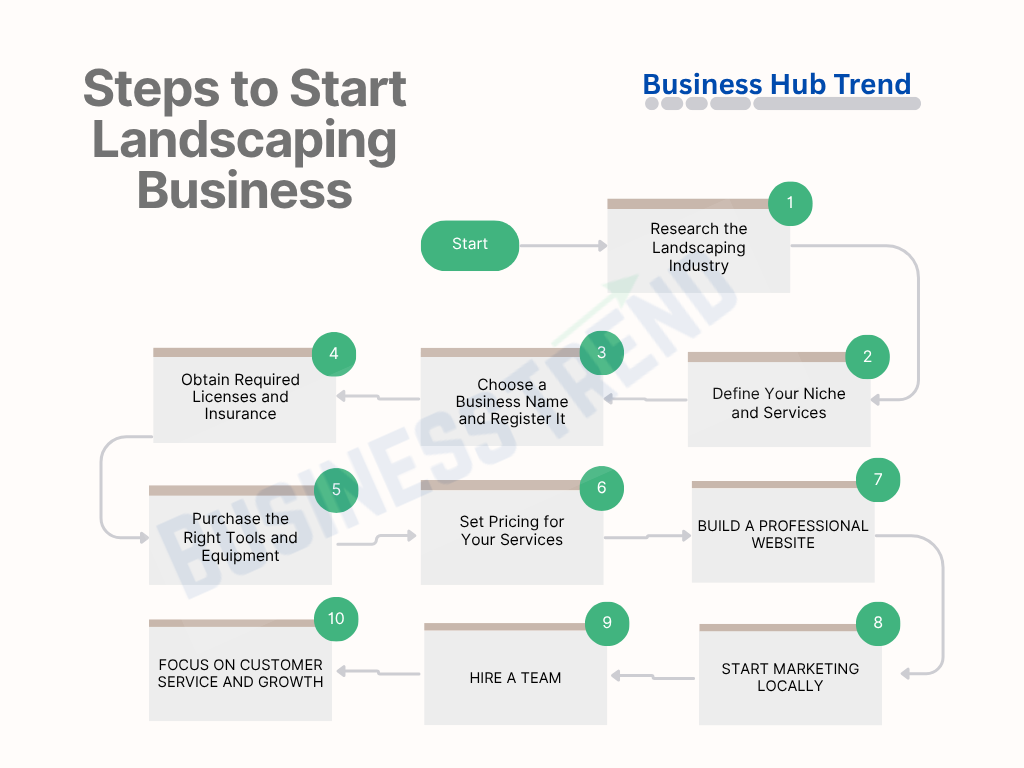A landscaping business offers services of improving the outlook appearance of various spaces. These services include lawn care, garden design and planting with maintenance. Landscaping business is related to homeowners, property managers and various companies. The main working of this business is to keep looking for the best yards, gardens etc.
The demand of this business is increasing day by day. Many people want neat, green and beautiful outdoors. They don’t have time or proper tools to manage them. That’s why they look for services. It creates opportunities for beginners to start this business.
If you have interest in landscaping, this is the best business for you. This article will provide you a complete guide and steps to start this business. We have covered everything in this useful article from business planning to marketing and growth.
There are 10 steps you need to follow for starting landscaping business.

Step 1: Research the Landscaping Industry
Take time to know the industry well before starting your business in landscaping. A good research allows you to choose wisely and avoid frequent problems.
First, find out about the demand for services where you are. Landscaping companies usually work most during certain seasons. A lot of places see their highest number of guests over the warm seasons of spring and summer. At this time, people hire help for services like mowing lawns, planting and clearing outdoor spaces. People require leaf removal in the fall. Most landscaping businesses have winter services that include clearing snow or shrub shaping.
Then, identify what types of services you would like to provide. Typically, clients choose lawn care, garden arrangement, hardscaping (patios and walkways) and routine upkeep. Decide whether you want to give all these services or just the ones you are equipped to offer.
Understand how landscaping for homes is not the same as landscaping for businesses. There are many residential jobs and each one may be smaller in size. Farmers usually earn more from their commercial projects, since these areas can be much bigger such as office parks or apartment complexes. Select the approach that is a good match for your aims and available resources.
Doing your research now will help you start with confidence and grow your business in the right direction.
Step 2: Define Your Niche and Services
- Decide if you’ll offer residential, commercial, or both types of services
- Choose your main services: lawn mowing, trimming, planting, hardscaping, etc.
- Focus on what you can do best with your current tools and experience
Set Your Budget
- Estimate startup costs (tools, equipment, licenses, insurance)
- Plan for monthly costs (fuel, maintenance, advertising, labor)
- Keep a small emergency fund for unexpected expenses
Set Clear Business Goals
- Short-term goals: Get your first 5–10 clients, break even in 3 months
- Long-term goals: Hire employees, expand services, or buy new equipment
Do a Basic SWOT Analysis
- Strengths: Experience, low competition in your area, flexible schedule
- Weaknesses: Limited tools, new to the business
- Opportunities: Growing local demand, eco-friendly landscaping trends
- Threats: Seasonal slowdowns, competition from big companies
Sample Landscaping Business Plan
| Section | Details (Example) |
| Niche | Residential lawn care and garden maintenance |
| Services | Lawn mowing, edging, seasonal clean-up, planting, hedge trimming |
| Startup Budget | $5,000 – includes basic equipment, licensing, insurance, and marketing materials |
| Monthly Budget | $1,000 – fuel, maintenance, marketing, insurance, and supplies |
| Short-Term Goal | Get first 10 local clients in 3 months |
| Long-Term Goal | Build a small team and expand to commercial properties in 1–2 years |
| SWOT Analysis | S: Low startup costW: Seasonal demandO: High local demandT: Competition |
Step 3: Choose a Business Name and Register It
At first, people notice business names. A clear, unique and professional business name build trust. It also helps you to stand out in the market.
You must be careful while choosing a name. Your business name should reflect your business. Choose a short name. Do not take too long name. You also need to check that no one other is using the same name. You can check it through the local business registry.
After selecting the name, check the availability of the domain for your website. A same name business website helps customers to find you online. It also helps you in branding.
After finalizing your name, register your business. Choose the right structure based on your needs:
- A sole proprietorship is simple and low-cost, ideal for one-person operations.
- An LLC (Limited Liability Company) offers legal protection and is a good option as your business grows.
- Other options include partnerships or corporations if you plan to work with others.
Proper registration makes your business legal and allows you to open a bank account, sign contracts, and pay taxes.
Quick Tips
- Pick a short and meaningful name
- Check for domain and social media handle availability
- Register your business with your local or state government
- Keep your paperwork organized for licenses, taxes, and insurance
Step 4: Obtain Required Licenses and Insurance
Make everything legal to secure your company before starting to provide landscaping services. As a result, customers trust you and you avoid facing future legal problems.
Check if the local regulations state that you need a landscaping license. For some places or countries, you might need a special permit to handle things like fertilizers or pesticides. Contacting your town hall or the local small business office will give you the correct information on rules.
Go on to purchase the right insurance coverage. The minimum requirement is general liability insurance. Liability insurance is there to cover any harm to a client’s home or items you may cause during the job. If you have employees, you must have workers’ compensation insurance in most places. It covers both you and your team if someone gets injured at work.
You will have to secure the required business permits and register for taxes. An Employer Identification Number (EIN) is necessary from the IRS for Americans, even if you currently do not have employees. A number of places also require a business license if you are running your company from home.
Checklist
- Check local landscaping license requirements
- Apply for general liability insurance
- Get workers’ compensation if you hire staff
- Register for an EIN and local business permits
Step 5: Purchase the Right Tools and Equipment
Every business needs some tools and equipment to work effectively. Starting with the right tools help you to grow your business and provide the best.


Here’s a list of essential tools to get started:
- Lawn mower
- String trimmer or weed eater
- Leaf blower
- Shovels, rakes, and pruning shears
- Wheelbarrow
- Safety gear like gloves, boots, goggles, and ear protection
To move from one place to another, you need a vehicle. A pickup truck is the best choice for this purpose. You can use your own vehicle if you already have one.
There are two options for you while buying equipment; new and old. New tools may be costly but come with guarantees. Used tools don’t have any guarantee but are cost effective. You can buy tools according to your budget.
Quick Tips
- Start with basic tools, upgrade as you grow
- Buy used tools from trusted sellers if you’re on a tight budget
- Keep your equipment clean and well-maintained
- Make sure your vehicle can carry all tools safely and legally
Having the right tools helps you to do professional work and save your time.
Step 6: Set Pricing for Your Services
Setting the right prices is key to running a profitable landscaping business. Your pricing should cover all your costs and still offer value to your customers.
Start by estimating the cost of each job. Include:
- Materials like mulch, plants, or fertilizer
- Time you’ll spend on the job
- Labor if you hire workers
Next, research what other landscapers in your area are charging. This gives you a good idea of market rates. Try to stay competitive without underpricing yourself. Think about value-based pricing—charge more for jobs that require special skills, tools, or design work.
You can also offer packages or subscription plans. For example:
- Weekly lawn care services
- Monthly garden maintenance
- Seasonal clean-up deals
These packages keep your income steady and make it easier for customers to book your services regularly.
Pricing Tips
- Always include travel time and fuel costs in your estimates
- Offer free quotes to attract new clients
- Avoid very low prices—they can hurt your profit and brand image
- Be clear and honest about your pricing in all marketing materials
A smart pricing strategy helps you grow your income while offering fair, reliable services to your clients.
Step 7: Build a Professional Website and Online Presence
In the modern world, all businesses need to be visible online. A high-quality website helps to attract more customers and build trust.
Make sure your website is mobile friendly with fast loading. Many people look for services on their phones. A poor website can waste your customers. Information about your services, contact options and reviews from customers must be easy to find on your website.
Perform simple SEO activities to help your website show up better on Google search results. You should also write title tags and meta descriptions that clearly describe each page. Set up individual pages for lawn care, designing gardens and your other services. This tells the search engine what you are about and benefits customers in finding you.
Also, make a Google Business Profile to show up in Google Maps and local search results. Using it is free and you can get reviews and contact info all in the same spot. Be sure to make a Facebook Page and set up a Yelp account also. They allow you to talk with your customers, post pictures of your work and collect feedback.
Step 8: Start Marketing Locally
Getting the first customer is important. The local market is the best place to find your first client. Start advertising in the neighbourhood where you want to work. Keep your message simple and clear. Add contact details and briefly explain the services.
In the beginning, you can offer a referral discount. It encourages happy customers to recommend your services to others. Moreover, you can offer seasonal promotions to attract more clients.
Build partnerships with local nurseries, garden centers, or hardware stores. They can refer customers to you, and you can recommend their products. This creates a win-win relationship and helps you reach more people.
Step 9: Hire a Team (Optional in Early Stage)
Growth in your business could require additional help to handle extra work. To run business smoothly, hire a team at the right moment.

Hire someone else if you want to work on larger projects. You might want to hire people only when you need them for the busy times, to keep your budget low. Get garden workers who have done landscaping before or have a positive work ethic.
Know the regulations for running the payroll and handling employee issues. Keep proper tracking of both the hours you work and the payments you receive. Always follow the labor laws in your area about taxes and benefits.
To relieve stress from employee management, you might appoint a professional to handle your bookkeeping or marketing. Employing staff to do these tasks helps you grow your business.
Step 10: Focus on Customer Service and Growth
A good customer service is the key to keeping your client happy and regular. Complete your projects in time. Delay in completion may affect your rating. Make a system to respond to calls and messages quickly.
Get online reviews from satisfied clients. It will help you to get the attention of more customers. Positive reviews build a good reputation.
Look for opportunities to offer extra services, like fertilization, seasonal clean-ups, or snow removal. Upselling these can increase your income and help clients keep their yards healthy all year.
Final Tips to Succeed in Your Landscaping Business
- Stay updated on the latest landscaping trends and eco-friendly practices.
- Join local business groups and industry associations for networking and support.
- Reinvest profits in better tools, equipment, and employee training.
- Focus on improving customer experience to build loyalty.
- Keep learning to enhance your skills and services.
- Build strong relationships within your community.
- Aim for steady, long-term growth rather than quick profits.
Conclusion
A landscaping business needs to be planned out and started wisely. Researching your industry, creating a good business plan and dealing with licenses, equipment and website are all important. Providing fair pricing, community marketing and good customer service will help you yo grow. No matter if you operate alone or as a team, this business provides a lot of opportunities. Having a strong plan and a dedication to landscaping can turn it into something you can grow. Using this process, you will be on the road to building a successful landscaping business. The time is right to do something and let your enjoyment of landscaping lead to a great career.
Frequently Asked Questions (FAQs)
- What licenses are required to open a landscaping business?
Licensing rules are different in each place. Find out from your local government if you must get a license or special permits to landscape.
- How much capital is needed to set up a landscaping company?
The amount you spend on tools, equipment and licenses will vary with what your business requires. Purchasing basic used equipment could cost you about a few thousand dollars to begin.
- Is it possible to open a landscaping business by myself?
A lot of landscapers first start working by themselves. Hiring others can be done later on when your company gets bigger.
- How do I set the costs for my landscaping jobs?
Add up your resources, the time you will spend, overhead expenses and storage needs. Packages and seasonal promotions can draw more clients.
- Which ways of marketing are most effective for the landscaping industry?
Flyers, recommendations, social media and listing on Google help you attract local customers.
- Can landscaping be a successful money-making endeavor for a business?
Proper organization, reliable service and targeted marketing can bring great rewards and make landscaping companies develop further.


2 Comments
Pingback: MintPro: Your Complete Guide to TurtlemintPro Insurance App for Advisors -
Interesting take on responsible gaming! Seeing platforms like 68jl casino prioritize security & verification is key for building trust, especially with mobile access via their app. Good read!